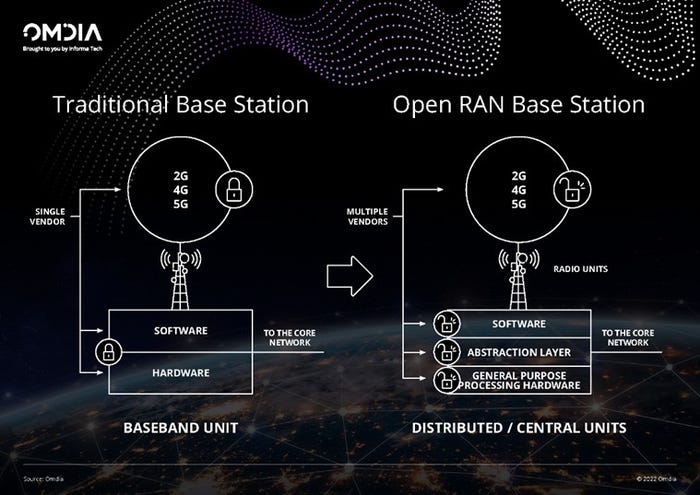The traditional ways of building RAN will no longer benefit MNOsThe traditional ways of building RAN will no longer benefit MNOs
Open RAN is a new approach to building mobile networks that are needed to connect our mobile and other devices to the internet.
November 4, 2022

Telecoms.com periodically invites expert third parties to share their views on the industry’s most pressing issues. In this piece Roberto Kompany, Analyst at our sister company Omdia, seeks to demystify some of the terminology associated with Open RAN.
Before assessing the importance of RIC in Open vRAN, we need to understand the term ‘Open Radio Access Networks (RAN)’. What does it mean? Open RAN is a new approach to building mobile networks that are needed to connect our mobile and other devices to the internet. It is a generic term that initially focused on open front-haul interfaces in the RAN to enable radio unit (RU) and baseband unit (BBU) or centralized unit/distributed unit (CU/DU) solutions from different vendors to interoperate. Still a bit confusing?
In a nutshell, Open RAN is a new way of building RAN. In the days of 3G-4G, a single vendor provided all the RAN network compounds, the interface between the RU and DU was proprietary.
Defining open vRAN
vRAN is defined as the disaggregation of RAN hardware and software, and the use of generic hardware to run RAN functions.
The Open vRAN 1.0 combines the principle of open RAN and vRAN. vRAN 1.0 disaggregates the BBU into CU and DU, and starts with the virtualization of CU, while the DU runs on purpose-built hardware.
In Open vRAN 2.0, CU and DU are virtualized and run on generic hardware.
O-RAN is the Open RAN Alliance, launched in 2018, which is an industry alliance composed of operators and vendors that help define and create specifications not just for the RAN front-haul interfaces but also for other new elements such as the RAN intelligent controller (RIC). Not all open RAN deployments are 100% compliant with the O-RAN Alliance specifications.
The RAN migration to open vRAN

In the early day of Open RAN known as Open vRAN 1.0, this is the first phase of operator Open vRAN deployment where the CU is virtualized, this process is a little bit simpler to do so and not so heavy computing is required. The DU is still purpose-built, UM and the RU are always sorts of physical infrastructure, physical as you can’t virtualize the RU because it’s a lot of an Analog elements.
Open RAN 2.0 is where we virtualize the DU, so it becomes a vDU. So that’s when you start having to rely on x86 to do the computing. But at the same time, you have to think about the which use case will be an efficient use of such an architecture. For example 4G and non-massive MIMO 5G use cases can be handled with x86.
With 5G massive MIMO, you have five times the amount of spectrum bandwidth compared to 4G networks. So, when you’re adding a lot of spectrum bandwidth and a lot more traffic significantly more computing will be required. And that’s where the x86 based vDU will struggle.
Open vRAN is part of that whole argument, how to make it more automated and enable new use cases? That’s it, the traditional way of building RAN will no longer benefit MNOs and where does RIC come into this conversation?
RIC in a nutshell adds intelligence to the RAN. RIC facilitates more optimization and automation, so you can’t do things in the old way of configuring manually. Watch out for the second blog on all things RIC, including an explanation of RIC architecture.
You can hear Roberto discussing the importance of RIC in Open vRAN strategies, including the key drivers of Open vRAN and the consequences of not implementing Open RAN within your business strategy, here.
About the Author
You May Also Like










.png?width=300&auto=webp&quality=80&disable=upscale)


_1.jpg?width=300&auto=webp&quality=80&disable=upscale)